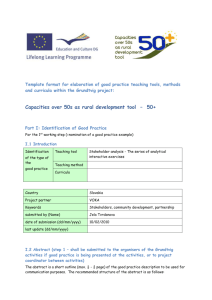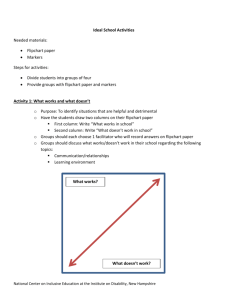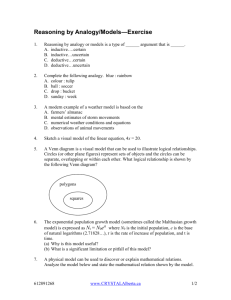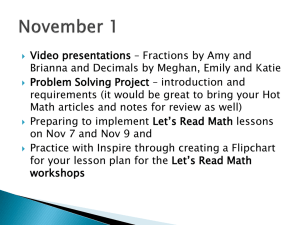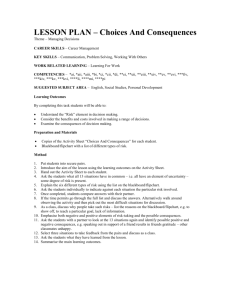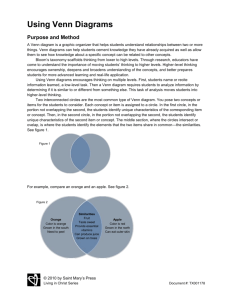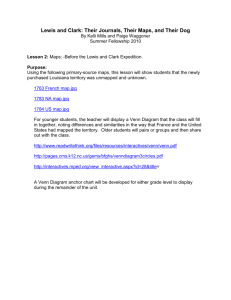Stakeholder analysis exercises
advertisement
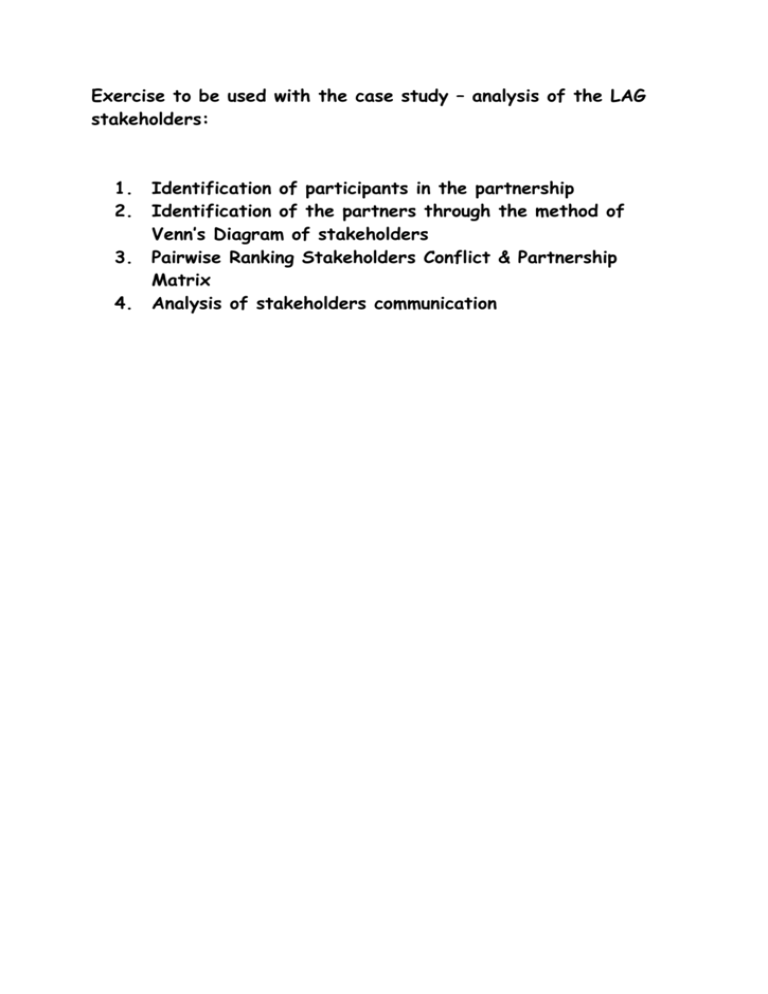
Exercise to be used with the case study – analysis of the LAG stakeholders: 1. 2. 3. 4. Identification of participants in the partnership Identification of the partners through the method of Venn’s Diagram of stakeholders Pairwise Ranking Stakeholders Conflict & Partnership Matrix Analysis of stakeholders communication Exercise 1 Identification of participants in the partnership Description: This exercise is to help with the identification of all important partners in terms of their formal or informal reputation, involvement in the decision making process, the opportunities of co-financing or any other possible sources that would contribute to successful implementation of the development process. Objectives: A list of all important stakeholders of the region development should be drawn up Materials: Flipchart, markers Steps: 1. The working group draws up a list of the local institutions, social groups, individual representatives and external organizations that should have the stake in the process of development through a brainstorming within a certain geographical region 2. The working group draws up a list of these stakeholders and numbers them The participants must identify as many institutions / partners as they can and arrange them on the flipchart as truthfully as possible in terms of the relationships the participants have with them. Supporting questions for the trainer during the group work: 1. Which institutions could influence upon the local development? What kind of influence is it – positive or negative? 2. Which potentila stakeholdes will gain/loose in the process? 3. Are there any associations which contribute to the economic development of the region? Which entrepreneurs should be included? 4. Are there any formal or informal leaders in the region? 5. What are the relationships between the domestic and external institutions (state government, non-governmental organizations, political groups etc.)? 6. Who has been most frequently excluded? Exercise 2 Identification of partners through the method of Venn’s Diagram of stakeholders Description: Venn’s Diagram of stakeholders will help us to identify and determine the significance/importance of any particular partner included in the planning process. The Diagram facilitates the assessment of the relationships, connections, conflicts among the partners and their influence upon the concrete region. Objectives: 1. To find out whois more and who is less important for the development of the area. 2. To find out who has the right to take decisions in the region (formally and informally) and who should be included in the process of development. 3. To identify the relationships and connections among the local institutions, social groups and independent representatives and find out what could be won or lost from the implementation of the actions planned in relation with the regional development. Materials: Flipchart, markers, self-adhesive variegated stickers cut in round shape of three sizes (small, medial and large) and three various colors for sectors – green for civil society representatives, blue for business and red for public administration reprsentatives. Steps: 1. Setting up of working sub-groups. 2. Each working group draws up a list of the local institutions, social groups, independent representatives and external organizations that should take part in the process of development within a certain geographical region (Alternative: the list is drawn up by the whole group through a brainstorming). The result of previous exercise can be used for this purpose. 3. Each working group determines the extent of importance of each identified partner by writing his name / appellation on one of the cut circles: large circle – great importance, medial circle – average importance, small circle – small importance. This is done for each sector separately. (The trainer should watch closely whether each partner’s colour differs from the others partners’ colours.). The results are three sizes and three colors defined partners. 4. The participants in the working group select the partners who re-cover in the characteristics. They place them on the flipchart paper (in which are two circles drawn (one in each other). The central circle means the centrum of the decision power, the surrounding circle means less power. 5. Partcipans place colored circles around these two circles respecting their mutual position. This means the connection between / among such partners is stronger and therefore the circles should be arranged on the flipchart as follows: separate circles – no contact, circles at a touch – exchange of information, small re-covering – certain cooperation in taking decisions, large re-covering – intensive cooperation in taking decisions. The participants should identify as many institutions / partners as possible and arrange them on the flipchart as truthfully as possible in terms of the relationships the participants have with them. After the work at groups the participants compare Venn’s Diagram of stakeholders and try to analyze the differences (a certain institution can be presented by different circles at different working groups – for example small and large). In this case the whole group should come to an agreement by discussion. Supporting questions for the trainer during the group work: 1. Which institutions could influence upon the regional development? What kind of influence is it – positive or negative? 2. Are there any associations which contribute to the economic development of the region? Which entrepreneurs should be included? 3. Are there any formal or informal leaders in the region? 4. What are the relationships between the domestic and external institutions (state government, non-governmental organizations, political groups etc.)? 5. Who has been most frequently excluded? Example of Venn Diagram in separate file Exercise 3 Pairwise ranking Stakeholders Conflict & Partnership matrix Description: The Pairwise Ranking Matrix will show the partnership/conflict situation among all identified partners, groups / members of the community. Objectives: 1. To determine the extent of partnership and conflicts among the various institutions, groups and independent representatives identified by Venn’s Diagram (Exercise 2) 2. To identify the impacts of the partnership and conflict on the process of development Materials: A copy of Venn’s Diagram from Exercise 2, flipchart with matrix prepared, sticky tape, markers, sheets A3, circles and rectangles of the same colour and three sizes Matrix on the partnerships and conflicts Partners Partner 1 Partner 2 Partner 3 Partner 4 Partner Partner 1 х Partner 2 +++ Partner 3 ++ Partner 4 +++ Partner 5 + Partner 6 – – – х х – – – ++ + х х х – – + +++ х х х х – – – + х х х х х ++ 5 Partner х х х х х 6 Description: +++ - very high level of partnership (commonly financed projects) ++ - medium level o partnership (regular meeting of partners) + - standard level of partnership (mutual communication withou any problem) ––– - very high level of conflict (do not want to attend the same meeting) –– - medium level of conflict (do not want to cooperate together) – - existing conflict of smaller size (lack of communication and understending) 0 - no relationship Steps: 1. Setting up of small working groups. 2. Each working group brings the list of identified partners into a previously drawn up matrix – vertically and horizontally. Besides the names / appellations of all partners must be written on the both sides of the coloured sheets. 3. Each group arranges the pluses and minuses by the different colour. The participants in the working group compare two partners and settle down the nature of their relationships: partnership (plus) or conflict (minus) and the intensity of these relationships (numbers of pluses and minuses from 1 – 3). 4. Following the group discussion and taking a decision the participants put the chosen form in the matrix. If there are no points of contact between the both partners (neither conflict nor partnership) the column is marked by 0. 5. It is recurring until the whole matrix is filled in. Then the matrix is analyzed within the group (the extent of partnership and х conflicts in the community, who are the partners involved in the conflict or partnership?). Supporting questions for the trainer: 1. Which of the partners have common interest and what kind of interest is that? 2. Is there any partnership between / among certain groups? If there is, what activities it is connected with? 3. Can the existing partnerships facilitate the process? 4. Can the new objectives strengthen these partnerships or turn into a source of new conflicts? Example in separate file Exercise 4 - Analysis of stakeholder´s communication Purpose It is always usefull to understand how various stakeholders of the development process communicate to each other and what is the general „culture of communication“ among them prior we star the development process and invite stakeholders to take part in development partnership. Objective To analyse the communication pattern and flows among various stakeholders of the development of the area and understand the situation prior the partnership starts to create and develop in order to aid the risk as much as possible and potentialy to prepare the efective communication plan. Material Prepared Communication pair wise matrix and communication graph, markers, identified stakeholders of future partnership (using previous exercises – Venn diagram, partnership and conflict matrix etc.) Steps - Participants work in groups (max 8 people) using the communication pair wise matrix, which help them to compare each pair of stakeholders and pattern of their communication. Very good communication pattern (information flow, the effort to discuss and have mutual communication etc.) is marked by number 2, medium communication pattern (only informatin flow without expectation to get an answer) is marked by 1 and no communication is marked by 0. - Participants compare pairs os stakeholders in both ways and fill the table – see the example below: Stakehold Youth . Youth xxxxx x Women 0 Women 1 Local adm. 1 Agricoo p 0 Civil as. Total pasive 2 4 0 0 2 2 2 2 4 2 3 xxxxxx x 8 6 Local adm. Agricoop 0 xxxxxx x 0 0 0 xxxxxx x 1 Civil as. 2 2 0 xxxxxx x 2 Total active 2 3 2 4 xxxxxx x - Participant calculate score of communication for each stakeholder – in active terms (how stakeholder communicates to the environment) and in pasive terms (how environment communites to him/her) - Then participants place each stakeholder in the map below and the group discusses the situation Pasive 8 Receivers communicators Both ways Civil association Youth Local adm Women Agricoop 0 8 No communication Donators Active
